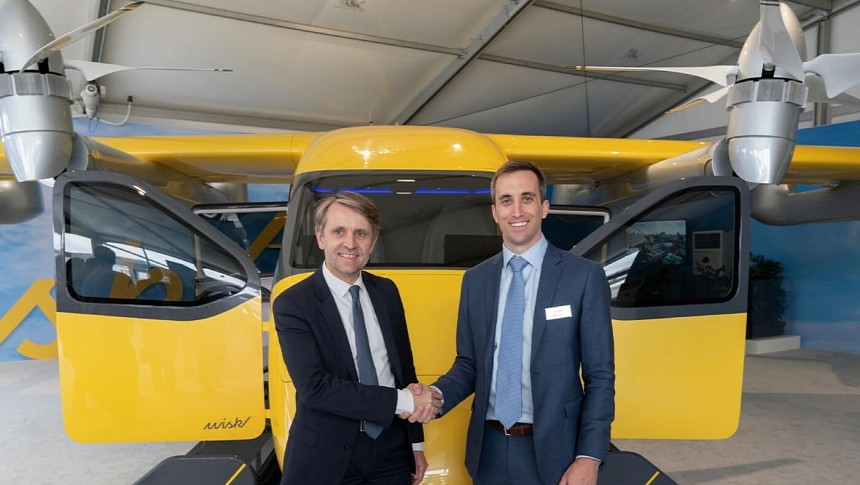The electric air taxi claiming to be the world's first that is also autonomous is getting a top-notch navigation system from Safran Electronics & Defense.
Like any new field, Advanced Air Mobility (AAM) is primarily a world of startups. Still, some eVTOL (electric vertical take-off and landing) developers have either emerged from larger aviation companies (like Embraer's Ever Air Mobility) or joined forces with them. Wisk Aero became a fully-owned subsidiary of Boeing this year. It continues to operate separately while benefitting from Boeing's support in essential aspects related to testing and certification.
Wisk Aero has worked on electric air taxi technology for over a decade. After more than 1,600 flight tests, it's proud to introduce its Generation 6 aircraft, claiming to be the first autonomous four-seat eVTOL in the world that's specifically designed for passenger transportation.
Certifying this pioneering autonomous electric aircraft for commercial service is no easy task. Safety is a key element, even more so than with standard eVTOLs. Wisk tackled this starting with the design (a simplified structure with minimal moving parts) and continuing with the avionics (fully redundant systems).
To that, Wisk is now adding a state-of-the-art navigation system, one of the critical components of any autonomous vehicle. The technology has a complicated name (HRG Crystal Hemispherical Resonator Gyroscope), but it's packed in a navigation system under the commercial name of SkyNaute.
The main advantage of Safran's SkyNaute is its high level of accuracy and reliability, even in challenging situations when GNSS satellite signals might be absent or jammed. This is essential for the safe operation of a self-flying air taxi like the Wisk eVTOL. SkyNaute also claims to provide this advanced technology in the most compact form available on the market – another plus when it comes to a smaller aircraft like this four-seat air taxi.
SkyNaute is a hybrid system combining conventional capabilities with inertial navigation. Inertial navigation systems are critical for any situation where there's no access to satellites or cell phone towers. They use specific sensors, gyroscopes, accelerometers, and computer processing to calculate a vehicle's position compared to a given starting point.
Submarines, military aircraft, drones, robots, or even vehicles passing through tunnels can use inertial navigation. This type of system is also able to recalibrate once GPS/GNSS connection is available to ensure high precision levels. Unsurprisingly, Safran's HRG technology was mainly used for military applications and will now bring its benefits to the world of autonomous air taxis.
Wisk unveiled the Generation 6 eVTOL last Fall. Boasting a 12-propeller design with extended booms, an upgraded propulsion system, and a smaller noise footprint. It promises a range of up to 90 miles (144 km) with reserves at a cruising speed of 120 knots (138 mph/222 kph).
Wisk Aero has worked on electric air taxi technology for over a decade. After more than 1,600 flight tests, it's proud to introduce its Generation 6 aircraft, claiming to be the first autonomous four-seat eVTOL in the world that's specifically designed for passenger transportation.
Certifying this pioneering autonomous electric aircraft for commercial service is no easy task. Safety is a key element, even more so than with standard eVTOLs. Wisk tackled this starting with the design (a simplified structure with minimal moving parts) and continuing with the avionics (fully redundant systems).
To that, Wisk is now adding a state-of-the-art navigation system, one of the critical components of any autonomous vehicle. The technology has a complicated name (HRG Crystal Hemispherical Resonator Gyroscope), but it's packed in a navigation system under the commercial name of SkyNaute.
The main advantage of Safran's SkyNaute is its high level of accuracy and reliability, even in challenging situations when GNSS satellite signals might be absent or jammed. This is essential for the safe operation of a self-flying air taxi like the Wisk eVTOL. SkyNaute also claims to provide this advanced technology in the most compact form available on the market – another plus when it comes to a smaller aircraft like this four-seat air taxi.
SkyNaute is a hybrid system combining conventional capabilities with inertial navigation. Inertial navigation systems are critical for any situation where there's no access to satellites or cell phone towers. They use specific sensors, gyroscopes, accelerometers, and computer processing to calculate a vehicle's position compared to a given starting point.
Submarines, military aircraft, drones, robots, or even vehicles passing through tunnels can use inertial navigation. This type of system is also able to recalibrate once GPS/GNSS connection is available to ensure high precision levels. Unsurprisingly, Safran's HRG technology was mainly used for military applications and will now bring its benefits to the world of autonomous air taxis.
Wisk unveiled the Generation 6 eVTOL last Fall. Boasting a 12-propeller design with extended booms, an upgraded propulsion system, and a smaller noise footprint. It promises a range of up to 90 miles (144 km) with reserves at a cruising speed of 120 knots (138 mph/222 kph).








